Key takeaways:
- Hospital ministry combines spiritual care with emotional support, fostering community and healing for patients.
- Support groups encourage sharing personal stories, which help dismantle feelings of isolation and create a sense of belonging.
- Storytelling within support groups serves as a powerful tool for connection, allowing individuals to share vulnerabilities and inspire resilience.
- Effective storytelling techniques, such as incorporating sensory details and inviting dialogue, enhance engagement and foster deeper connections among participants.
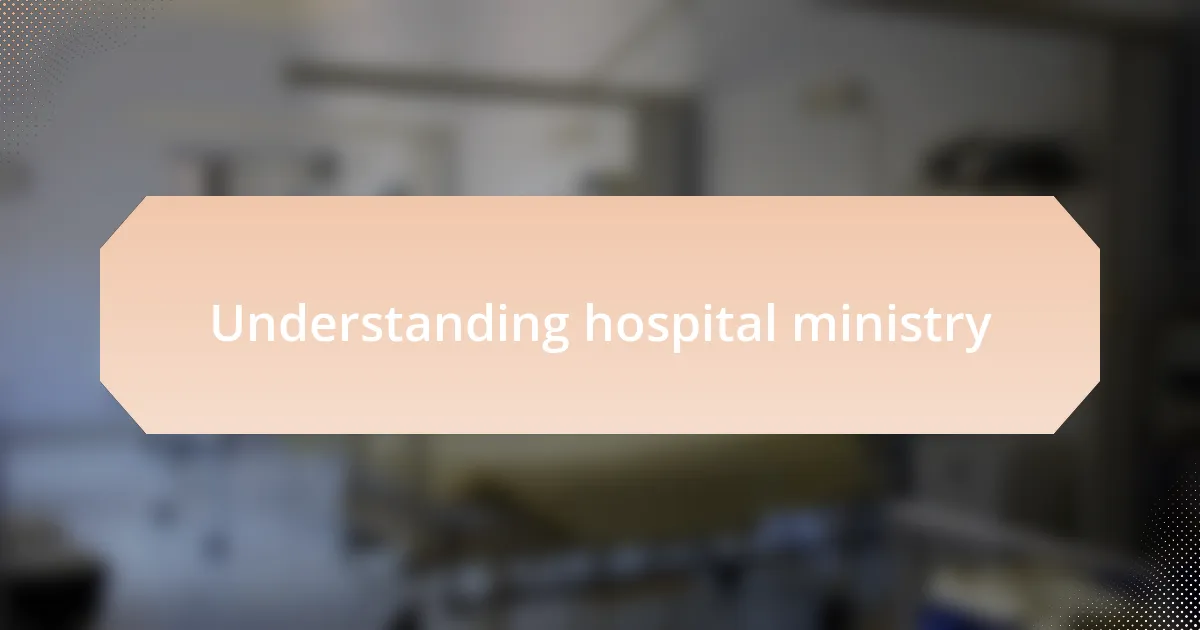
Understanding hospital ministry
Hospital ministry is a unique form of spiritual care, bridging the gap between faith and health. I remember a time when I sat with a patient grappling with fear. In that moment, I realized how powerful it is to provide not just prayers but also emotional support, fostering a sense of community during their healing journey.
Engaging with patients in this setting allows us to witness firsthand the deep intersection of vulnerability and faith. Have you ever felt the weight of someone’s pain in such a close manner? In those quiet moments, I’ve found that sharing stories — yours and theirs — creates a thread of connection that can be profoundly comforting.
The essence of hospital ministry lies in understanding each person’s story and how it shapes their experience in healthcare. When I share my own struggles, it breaks down barriers, inviting others to open up. This reciprocal exchange not only nurtures wellbeing but also ignites hope, reminding us all that we are not alone in our battles.
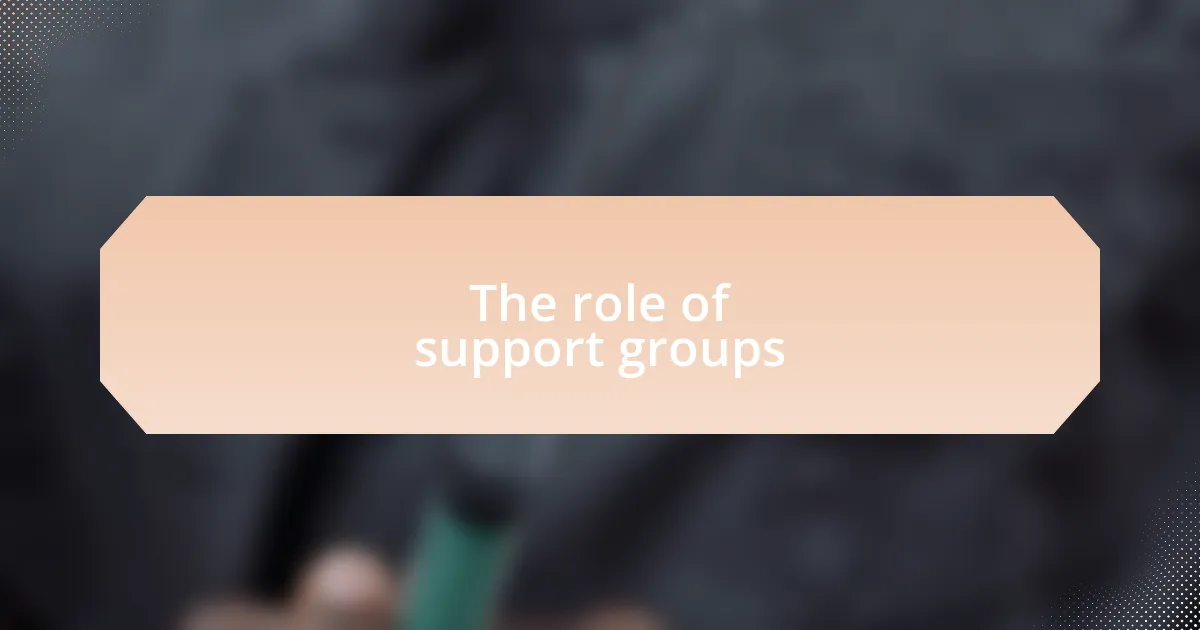
The role of support groups
Support groups play a vital role in fostering an environment where individuals can express their feelings and experiences openly. I vividly recall a session where a member spoke about their family’s struggle with illness, and within moments, others were sharing their own stories. This exchange not only validated each person’s feelings but also forged connections that often lead to healing.
It’s astonishing how the simple act of sharing can uplift spirits. I’ve seen members lean on each other, forming a community where laughter and tears coexist. Have you ever been part of a group where you felt understood? In support groups, such moments help dismantle the isolation that so many face, creating a sense of belonging that is incredibly powerful.
Through shared narratives, support groups encourage individuals to reflect on their journeys. I remember one participant who initially felt hesitant to speak but gradually found their voice. Their story resonated with many, highlighting how mutual support can transform despair into hope. That kind of growth is what makes support groups not just helpful, but essential.
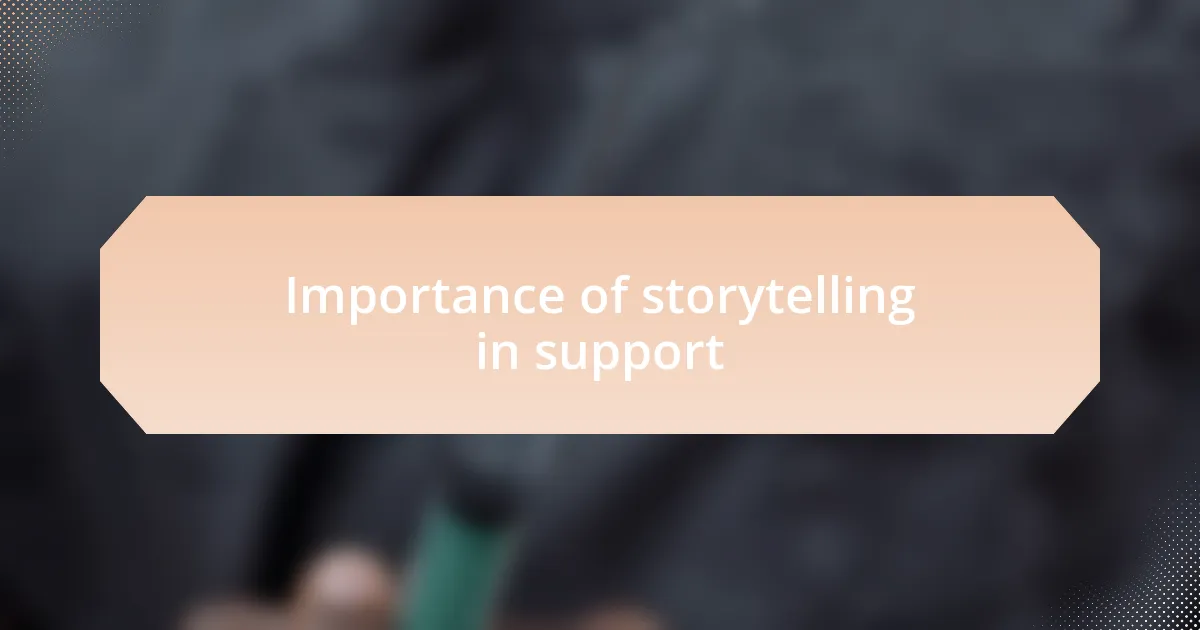
Importance of storytelling in support
Storytelling in support groups serves as a bridge that connects individuals on a deeply emotional level. I remember hearing a story from a member about the fear of losing a loved one, and it struck a chord with me. It was as if that one narrative encapsulated the collective anxiety many feel, creating a safe space to explore such vulnerable emotions together. Isn’t it comforting to think that our experiences can resonate with others in profound ways?
When people share their stories, they not only find solace but also inspire resilience in one another. I recall a session where a member openly shared their journey from addiction to recovery. That courage ignited a spark in others, who began to share their struggles and triumphs. It reminded me that storytelling can be an act of bravery that encourages ongoing strength and transformation. How often do we underestimate the power of sharing our truths?
Each story told in a support group can lighten the heavy burdens we carry. I once witnessed a participant break down while recounting their experience, yet as they shared their pain, the room filled with supportive nods and affirmations. It became evident that storytelling is a tool for healing, helping individuals confront their struggles and illuminating paths that seemed shrouded in darkness. Have you ever realized how much healing can happen simply by listening?
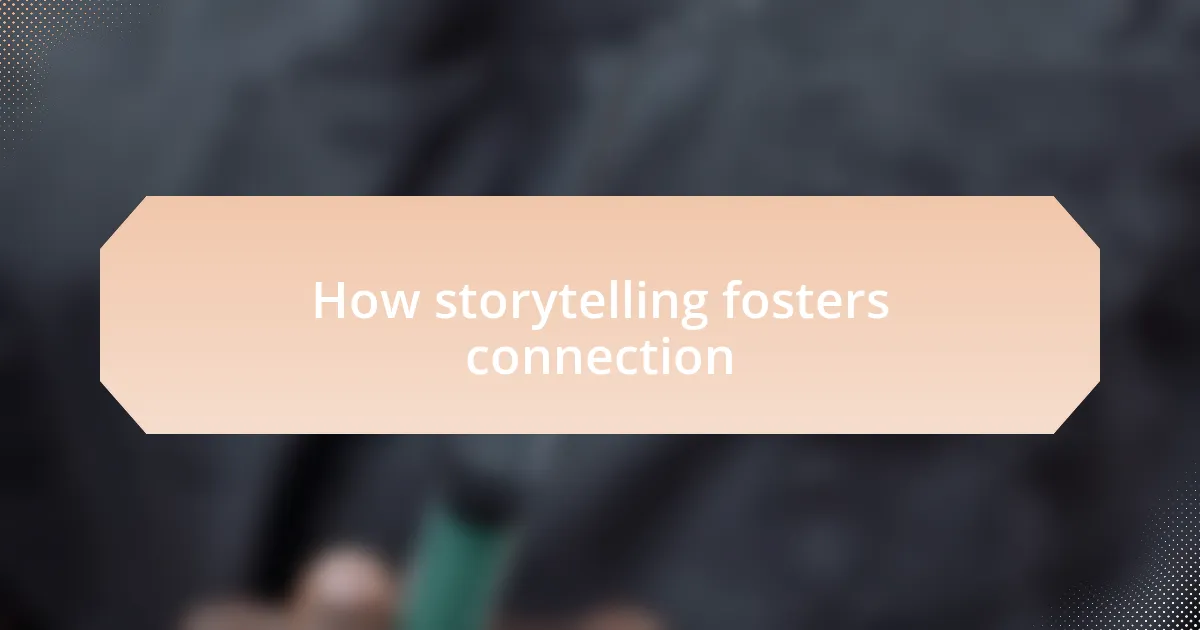
How storytelling fosters connection
When I witness someone share their story, it feels like watching a delicate flower bloom in the midst of a barren landscape. There’s something uniquely powerful about seeing vulnerability unfold; it’s in those moments that people begin to realize they’re not alone in their feelings. Have you ever noticed how, as one person opens up, others start to lean in, eager to connect through shared experiences? It’s a beautiful reminder that we all crave connection, especially during our most challenging times.
One of the most profound connections I’ve experienced in support groups happened when a participant recounted their struggle with loss. As they spoke, tears flowed freely, and I could feel the weight of their sorrow hanging in the air. Suddenly, another member shared a similar tale, and it felt as though those two stories intertwined, creating an invisible thread of empathy that united everyone in the room. This moment reinforced my belief that storytelling is not just about sharing experiences—it’s about weaving a tapestry of understanding and compassion among listeners.
In my journey with storytelling in support groups, I’ve learned that these narratives often serve as open invitations for dialogue. When one person bravely shares their truth, it gives permission to others to do the same. I can’t count how many times a single story has catalyzed an entire conversation, sparking insights and reflections that might have remained unspoken otherwise. Don’t you find it fascinating how a simple act of sharing can invite deeper discussions and forge lasting bonds?
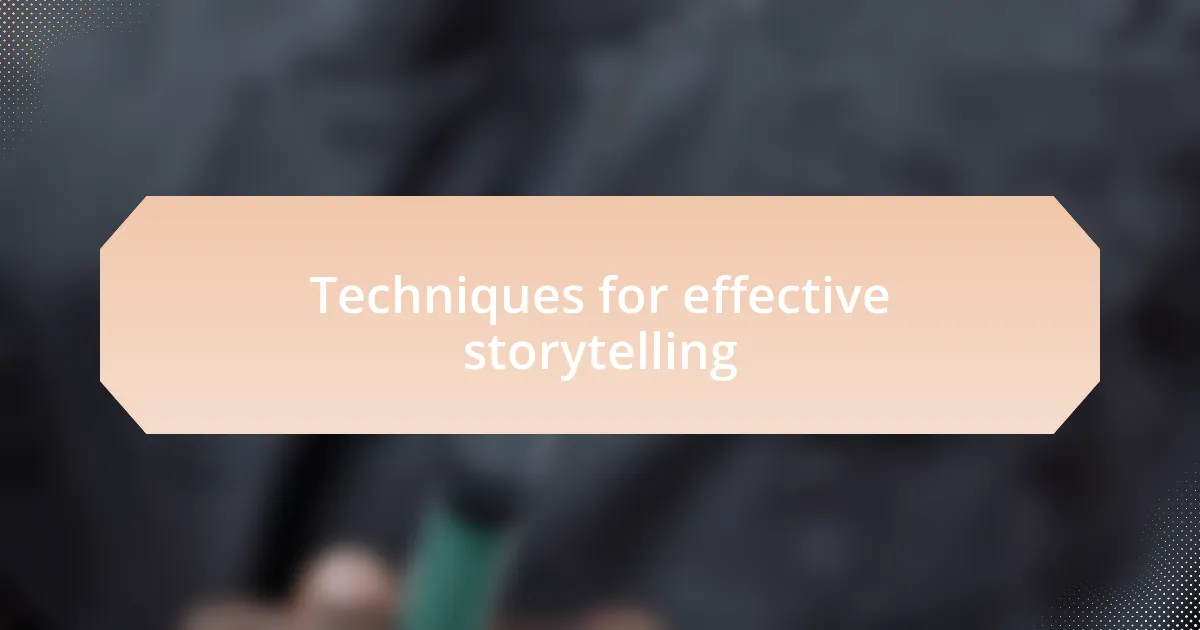
Techniques for effective storytelling
When I think about effective storytelling, I’ve found that the way I structure my narrative can make a world of difference. I often start with a vivid scene to draw listeners in, painting a picture that helps them visualize my experience. For instance, when I share about a particularly tough moment in my life, I focus on sensory details—what I saw, felt, and even heard. This technique not only heightens engagement but also allows others to experience those emotions alongside me. Isn’t it amazing how a well-chosen detail can spark empathy and understanding?
Another technique I swear by is the power of vulnerability. I find that when I share my true emotions—whether it’s fear, joy, or uncertainty—others resonate more deeply with my story. There’s something comforting about knowing that we all struggle sometimes. In one session, I opened up about my anxiety before a big event, and you could see people’s heads nodding in agreement. It was clear that many had faced similar fears, which prompted a wave of shared stories about overcoming self-doubt. Why do you think we feel stronger when we see our struggles reflected in someone else’s journey?
Lastly, I’ve learned that incorporating questions into my storytelling encourages more dialogue. By inviting thoughts or reflections, I create an atmosphere of open communication. For example, I might finish a personal story and then ask, “Has anyone else experienced something like this?” This simple invitation can lead to unexpected revelations and deeper connections within the group. I believe that stories are just the starting point—they can ignite conversations that help us explore our insights and shared humanity. How cool is it that a question can transform a simple story into a collective exploration?

Personal experiences with storytelling
Storytelling has been a profound tool in my own journey within support groups. I remember a moment when I shared a memory from my childhood, where I felt isolated and misunderstood. As I spoke about the seed of resilience that grew from that experience, I saw nods of recognition across the room. It struck me how powerful it is to reveal those moments of connection—when others can say, “I’ve been there too.” Isn’t it incredible how our stories can bridge the gaps between us?
There was another occasion when I recounted a time I had to confront a significant loss. As I detailed the raw emotions I felt, I could see the urgency in people’s eyes—they were not just listening; they were engaged on a deeper level. I felt a warm wave of support wash over me when I talked about the little rituals I created to cope. This vulnerability not only helped me process my grief but also encouraged others to share their stories of loss and healing. It made me wonder: why do we find solace in sharing our hardships?
The beauty of storytelling is that it has a way of turning our struggles into shared experiences. Once, I told a light-hearted story about a mishap during one of our group outings, and the laughter that followed created an instant bond. It was refreshing to see how humor can be woven into our narratives, creating a space where joy can coexist with pain. I realized then that storytelling is not just about the heavy topics; it’s about celebrating the full tapestry of life. How often do we forget that in our difficult moments, there can also be joy waiting to be uncovered?
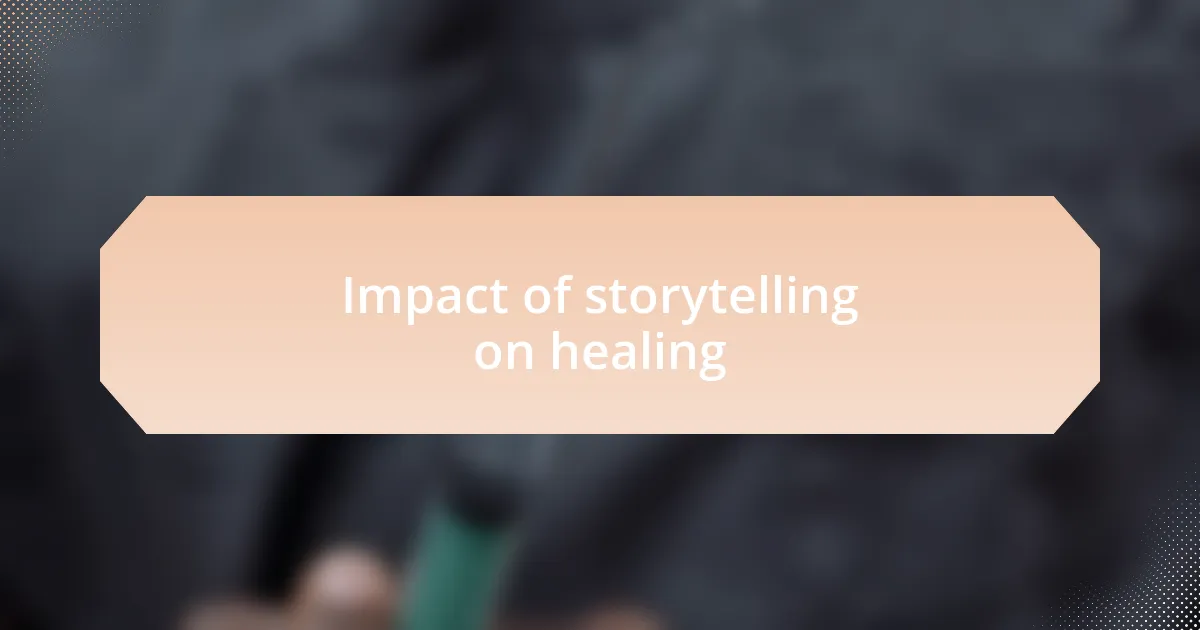
Impact of storytelling on healing
Storytelling profoundly impacts healing, both for the storyteller and the audience. I once witnessed a member share her journey through addiction, her voice trembling yet resolute. As she navigated the painful memories, it was evident how her vulnerability catalyzed healing—not just for her but for those who listened. Have you ever experienced a moment when someone’s story resonated so deeply that it felt like a balm for your own wounds?
What amazes me is how stories can encapsulate complex emotions and experiences. During a group meeting, I chose to recount a sensitive incident from my life involving betrayal and the gradual journey towards forgiveness. As I spoke about the transformative power of compassion, I saw tears in several eyes. In that shared silence, it was clear that the narrative had opened a channel for collective healing—momentarily easing the weight of our burdens. Isn’t it powerful when we can articulate our struggles and find others who share similar paths?
The act of storytelling fosters a community of empathy and understanding. I vividly remember a session where someone shared their journey with mental health challenges. As they described their despair and the small victories of each day, it sparked an open dialogue. Everyone around the table began sharing their own experiences, creating a ripple effect of support and validation. Isn’t it amazing how a single story can ignite a chorus of voices, all enriching the healing process for one another?